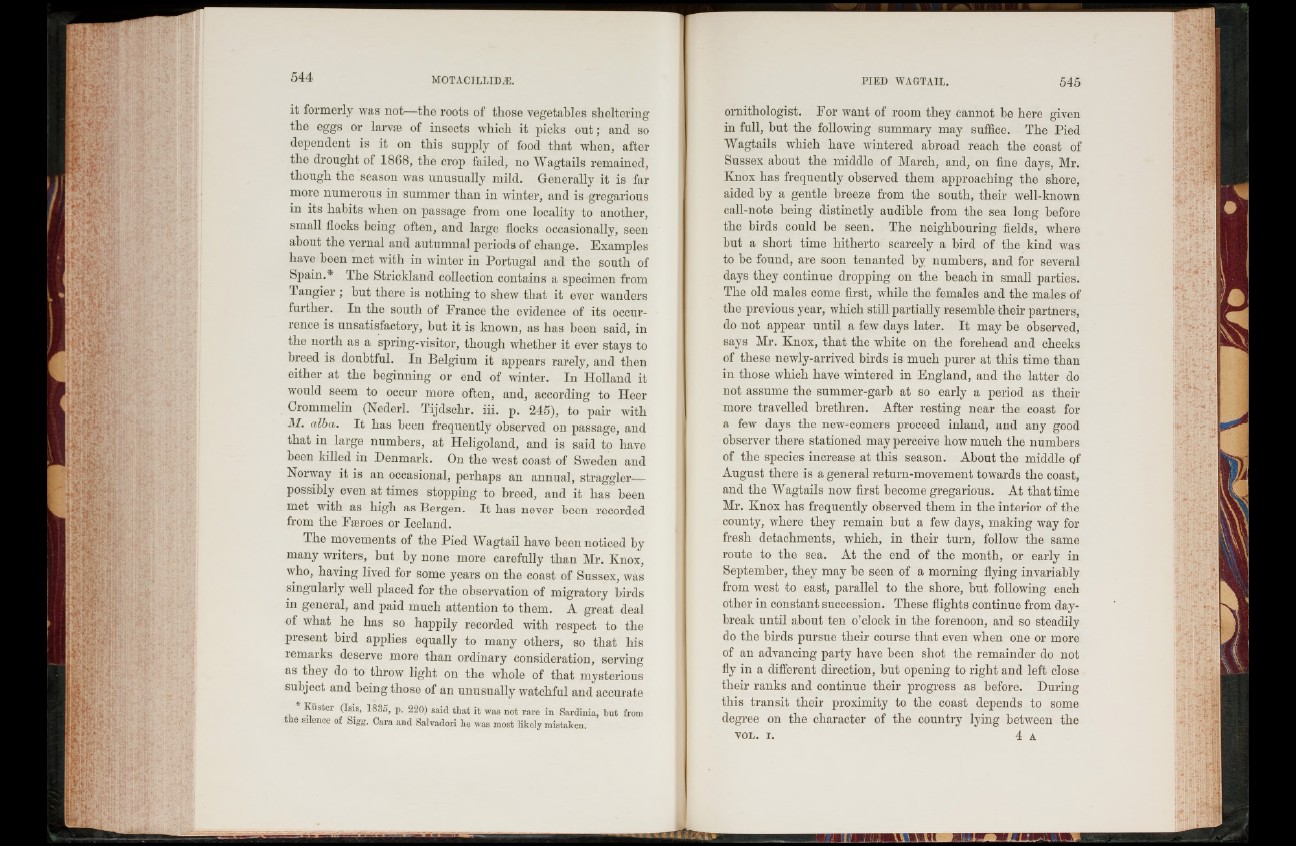
it formerly was not—the roots of those vegetables sheltering
the eggs or larvae of insects which it picks o u t; and so
dependent is it on this supply of food that when, after
the drought of 1868, the crop failed, no Wagtails remained,
though the season was unusually mild. Generally it is far
more numerous in summer than in winter, and is gregarious
in its habits when on passage from one locality to another,
small flocks being often, and large flocks occasionally, seen
about the vernal and autumnal periods of change. Examples
have been met with in winter in Portugal and the south of
Spain.* The Strickland collection contains a specimen from
Tangier ; hut there is nothing to shew that it ever wanders
further. In the south of France the evidence of its occurrence
is unsatisfactory, hut it is known, as has been said, in
the north as a spring-visitor, though whether it ever stays to
breed is doubtful. In Belgium it appears rarely, and then
either at the beginning or end of winter. In Holland it
would seem to occur more often, and, according to Heer
Crommelin (Nederl. Tijdschr. iii. p. 245), to pair with
M. alba. I t has been frequently observed on passage, and
that in large numbers, at Heligoland, and is said to have
been killed in Denmark. On the west coast of Sweden and
Norway it is an occasional, perhaps an annual, straggler—
possibly even at times stopping to breed, and it has been
met with as high as Bergen. I t has never been recorded
from the Fteroes or Iceland.
The movements of the Pied Wagtail have been noticed by
many writers, hut by none more carefully than Mr. Knox,
who, having lived for some years on the coast of Sussex, was
singularly well placed for the observation of migratory birds
in general, and paid much attention to them. A great deal
of what he has so happily recorded with respect to the
present bird applies equally to many others, so that his
lemaiks deserve more than ordinary consideration, serving
as they do to throw light on the whole of that mysterious
subject and being those of an unusually watchful and accurate
Kuster (Isis, 1835, p. 220) said that it was not rare in Sardinia, but from
t e silence of Sigg. Cara and Salvadori he was most likely mistaken.
ornithologist. For want of room they cannot he here given
in full, hut the following summary may suffice. The Pied
Wagtails which have wintered abroad reach the coast of
Sussex about the middle of March, and, on fine days, Mr.
Knox has frequently observed them approaching the shore,
aided by a gentle breeze from the south, their well-known
call-note being distinctly audible from the sea long before
the birds could be seen. The neighbouring fields, where
but a short time hitherto scarcely a bird of the kind was
to he found, are soon tenanted by numbers, and for several
days they continue dropping on the beach in small parties.
The old males come first, while the females and the males of
the previous year, which still partially resemble their partners,
do not appear until a few days later. I t may be observed,
says Mr. Knox, that the white on the forehead and cheeks
of these newly-arrived birds is much purer at this time than
in those which have wintered in England, and the latter do
not assume the summer-garb at so early a period as their
more travelled brethren. After resting near the coast for
a few days the new-comers proceed inland, and any good
observer there stationed may perceive how much the numbers
of the species increase at this season. About the middle of
August there is a general return-movement towards the coast,
and the Wagtails now first become gregarious. At that time
Mr. Knox has frequently observed them in the interior of the
county, where they remain hut a few days, making way for
fresh detachments, which, in their turn, follow the same
route to the sea. At the end of the month, or early in
September, they may be seen of a morning flying invariably
from west to east, parallel to the shore, hut following each
other in constant succession. These flights continue from daybreak
until about ten o’clock in the forenoon, and so steadily
do the birds pursue their course that even when one or more
of an advancing party have been shot the remainder do not
fly in a different direction, but opening to right and left close
their ranks and continue their progress as before. During
this transit their proximity to the coast depends to some
degree on the character of the country lying between the
v o l . i . 4 a